How To Animate Items In Geometry Dash
| Trigger | Setup menu | Description |
|---|---|---|
 | 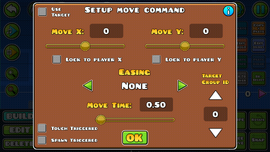 | Move triggers are triggers that move sure groups of objects effectually in a level. To use this the actor will have to know how to grouping objects under a specific group. Once the actor has given the grouping of objects a group ID, they may open the "Edit Object" menu while the move trigger is selected. The player will get a Movement X input, a Move Y input, two checkboxes labelled "Lock to player X/Y", an Easing option, a moving time, a target Grouping ID, and the touch-triggered and spawn-triggered checkboxes. The Target Group ID controls which group of objects the thespian are currently going to be moving. Fix the number equal to the number of the group that the thespian want to motility. The thespian can then change the Movement Ten and the Motion Y to control the amount of move the grouping will move.
The "Lock to Histrion Ten/Y" checkboxes will ignore the number inputted to a higher place them and will instead move the grouping perfectly to any move the player makes. Information technology volition look like the object is moving at the same speed of the player, or is simply not moving at all depending on how much of the level the role player see. Applying two locking to actor 10's will brand the objects move twice the speed of the player. If enough objects are in the group and are used correctly, it can make it seem like the player is moving backwards through the level. The easing controls the distribution of movement across time. Some are easy to understand, such as "bounciness", just others are not as straightforward and if used creatively can achieve special furnishings (for case, the sine easing allows round motion of objects). The movement time controls how long it will take to complete the movement. As presently as that much time has elapsed, the group will exist at the target destination and will stop moving, unless at that place is another motion trigger. Similar to colour triggers, the time range is from 0.00s to 10.00s and tin can be set for more than that manually. Triggers and speed portals can just be moved vertically. Form portals' grids will not move with the portals, making it possible to make an offset of the grid. |
 | 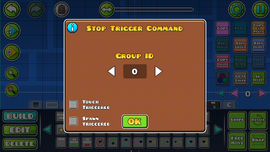 | The stop trigger terminates the functions of all triggers within a selected grouping. To exercise this, the actor must input the group ID of a trigger they wish to stop in the text box labelled "Group ID," and identify the trigger in a convenient location. This trigger incorporates the Spawn-Triggered and Touch-Triggered options and appears as magenta in the level editor. |
 | 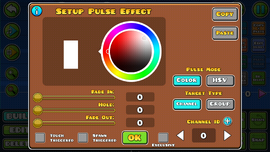 | Pulse Triggers will alter a colour channel or group to one colour temporarily. In the bottom-right of the screen, there should exist a field marked "Channel ID". Right above it are two buttons, 1 labelled "Channel" and one labelled "Grouping". The channel button will cause all objects using or copying the specified channel to pulse, while the grouping button will exercise the same except it will bear upon all objects using a grouping. To a higher place those ii are two more buttons, 1 reading "Colour" and the other "HSV". Color should be automatically selected and will cause the colour wheel to appear. A color may be chosen from there to crusade the specified group/channel to pulse the chosen colour. The HSV is for selecting colours similar to another and will modify when the source colour is inverse. Below the HSV options/colour wheel, there are three sliders, i "Fade-In," one "Hold," and 1 "Fade-Out." These are self-explanatory; the values in the fields should friction match the fourth dimension in seconds the colour should fade in, stay, and fade out respectively. Like to Colour Triggers, there are ii buttons labelled Copy and Paste in the meridian-right, both serving the same function. This trigger appears as xanthous in the level editor. |
 | 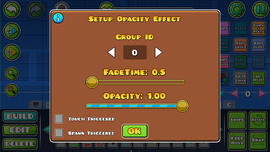 | Alpha triggers are triggers that affect the transparency of a group of objects. Nether the Group ID field, at that place are two sliders: FadeTime and Opacity. FadeTime is the fourth dimension in seconds it should take for the specified group to reach the opacity selected using the Opacity slider. This trigger appears equally cyan in the level editor. |
 | 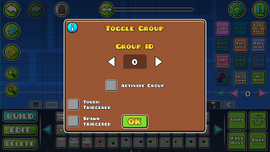 | Toggle triggers completely (de)activate a group of objects. If the tick box "Actuate Group" is left unticked, the group will immediately disappear when passing past the trigger and the player can go through whatsoever platforms or obstacles in this particular group. If it is ticked, then the opposite will happen: the group will reappear and the player will non be able to pass through the hazards and static objects. Note that toggle triggers tin can take on ii unlike colours in the editor depending on whether they are prepare to on or off. When information technology activates a group, it appears dark-green. When it deactivates a group, information technology appears red. In the editor, information technology appears as default ruby. |
 | 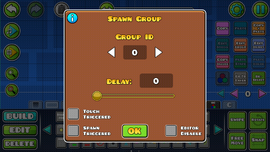 | Spawn triggers activate a sure group of triggers that are marked "Spawn Triggered". When activated, the group to be activated will be triggered at the aforementioned time, regardless of horizontal placement. In Update 2.1 the trigger was updated with an option to filibuster the group'due south activation with a slider. By default, the triggers activated past a spawn trigger can merely be triggered in one case, even if the histrion passes by multiple spawn triggers activating the same triggers. This can be changed by checking the "Multi Activate" box in the triggers being spawn triggered. This trigger appears as teal in the level editor. |
 | 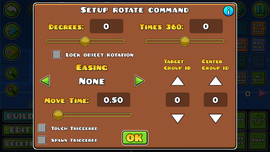 | Rotation triggers permit the actor to rotate objects within levels. In this trigger's edit card, there is a degrees slider, a Times 360 slider, 3 checkboxes labelled "Target Grouping ID," "Centre Grouping ID," and "Lock Object Rotation," an easing option, a moving fourth dimension, and the touch-triggered and spawn-triggered checkboxes. The target group is the grouping of objects that are to be rotated; the center group is the object the target group volition rotate around. As stated in this trigger's aid text, only i object tin exist in the center group. The number of degrees the target group will rotate is circumscribed by the "degrees" slider, and the "Times 360" slider defines how many times the objects volition rotate by 360 degrees aslope the amount determined by the "degrees" slider. Selecting "Lock object rotation" will keep the objects in their original position upon and throughout their rotation. Not selecting this will result in the rotation of the objects within the target grouping around their own axises, corresponding with the degrees each object rotates around the centre grouping. The move time controls how long it will take to complete the motility. As soon as that much fourth dimension has elapsed, the group will be at the target destination and will stop moving, unless there is some other rotation trigger. Similar to move triggers, the time range is from 0.00s to 10.00s and can be set for more than than that manually. The easing controls the distribution of movement beyond time. Some are easy to understand, such every bit "bounce", just others are not as straightforward and if used creatively can accomplish special effects. |
 | 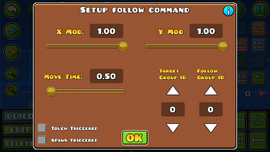 | The follow trigger allows specific objects to follow other objects that are being moved with the move trigger. This trigger'due south edit carte du jour includes iii sliders and two selectors: "X Mod," "Y Modernistic," "Move Time," & "Target Group ID," and "Follow Grouping ID." The "target" group is the objects that will follow the specified "follow" group. The target grouping will just follow the "follow" grouping if the objects therein are moving. The X-modification and Y-modification sliders define how abnormal the target destination will exist in reference to the follow group's destination. Setting 1 every bit the X or Y-Mod will upshot in a complete movement to the X or Y-position the follow grouping is at. Therefore, the numbers are based on percentages: -1 would be a -100%, or exact opposite, movement; 0.5 would be a l%, or half-finished, movement, and and so forth. The 10 and Y-Mod ranges are from -1 to 1, merely it can be prepare for more than than manually. The move fourth dimension controls how long it will have to consummate the movement. As soon every bit that much time has elapsed, the group volition stop moving, regardless of whether it is at the target destination or non, unless there is another follow trigger. Like to colour, move and rotation triggers, the time range is from 0.00s to 10.00s and can be set up for more than than that manually. This trigger includes the Spawn-Triggered and Touch-Triggered options and appears as hot-pink in the level editor. |
 | 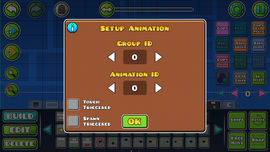 | This trigger grants the manipulation of animations' movements. In this trigger's edit card, in that location are 2 selectors: "Grouping ID" and "Animation ID." The Grouping ID is the animation(due south) that the player wants to breathing (this trigger does not work on non-blithe objects). Animation IDs are numbers assigned to specific animated object's movements; editing this changes said an animated object'southward movement. Below is a list of animation IDs for each animated object. Bat
Monster (Large Beast)
|
 | 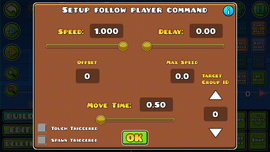 | This trigger is a variation of the Follow Trigger; it allows selected objects to follow the player in the Y-axis. In this trigger's edit menu, there are 3 sliders, ii input boxes, and i selector: "Speed," "Filibuster," "MoveTime," "Offset," "Max Speed," "Target Group ID,". The Speed slider is the multiplier of the target group'due south velocity when following the Player's Y axis position, the max existence the player's Y velocity. The Filibuster slider controls how much time it should laissez passer before the target group goes to the Thespian's Y-Axis current position. The "Move time" slider is how long the role should take outcome. The "Offset" input box tells what position the target group should be (Positive number being higher up the role player, negative being below) This trigger includes the Spawn-Triggered and Touch-Triggered options and appears as vanilla in the level editor. |
 | 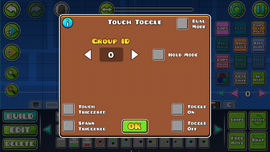 | The affect trigger may be configured to make tapping/belongings the screen (or the mouse) (de)actuate a group of objects. In this triggers edit menu, there is 1 selector and four tick boxes: "Grouping ID," "Dual Manner," "Hold Mode," "Toggle On," & "Toggle Off." If the "Dual Fashion" tick box is left unticked, the trigger works for both of the icons if the player is in dual mode. If it is non, the trigger only works with the original icon. If the player checks the tick box labelled "Hold Mode," the trigger functions as long as the player is belongings down on their mouse, screen, or spacebar, and the player's icon is past the trigger or inside it (if the touch-triggered tick box is ticked). "Toggle On" and "Toggle Off" determines whether or not holding/tapping/clicking volition toggle the specified group on or off. If left unchecked, continued tapping will bike between toggle on and off. In "Hold Fashion", belongings will toggle on and releasing will toggle off, only if "Toggle On" is selected, the deportment are reversed. This trigger includes the Spawn-Triggered and Touch-Triggered options and appears every bit cyan in the level editor. |
 | 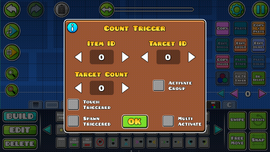 | Count triggers are used to trigger actions subsequently the role player has nerveless a specific amount of items. In this trigger's edit carte, at that place are three selectors and two tickboxes: "Item ID," "Target ID," "Target Count," and "Actuate Group," and "Multi Activate." The target group is the group that is to exist (de)activated; the item grouping is the group of items that are deemed the collectables; the target count is the corporeality of items needed to (de)activate the target group. The player may select whether or not achieving the target count deactivates or activates the target group with the "Activate Group" tick box (ticked = activates; unticked = deactivates). In correspondence with this trigger, there is a alive object counter that shows the player'due south progress regarding how many of the specific items they have nerveless. This trigger includes the Spawn-Triggered and Touch-Triggered options and appears as light-pink in the level editor. |
 | 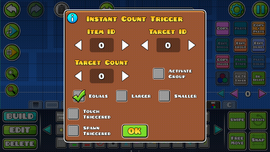 | The instant count trigger serves as a secondary, conditional Count Trigger. This trigger's edit carte du jour is most identical to that of the Count Trigger'south, there are three selectors and 4 tick boxes: "Detail ID," "Target ID," "Target Count," and "Activate Group," "Equals," "Larger," & "Smaller." The target grouping is the group that is to be (de)activated; the item grouping is the group of items that are deemed the collectables; the target count is the number of items that determines when the target group volition be (de)activated. The tick boxes, "Equals," "Larger," and "Smaller", determine when the target group will be (de)activated.
The role player may select whether or non achieving the target count deactivates or activates the target group with the "Activate Grouping" tick box (ticked = activates; unticked = deactivates). This trigger includes the Spawn-Triggered and Impact-Triggered options and appears as pink in the level editor. |
 | 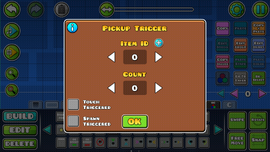 | The pickup trigger serves as a secondary count trigger. In that location are 2 selectors in this trigger's edit menu: "Detail ID" and "Count." The item ID is the ID given to an object counter and the "count" selector defines which number the counter should begin counting on. This trigger includes the Spawn-Triggered and Bear upon-Triggered options and appears as orange in the level editor. |
 | 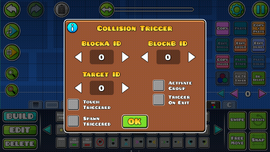 | The standoff trigger sets off an activeness upon ii selected collision block'southward encounter. Information technology uses a special block called "Standoff block" The player is to assign IDs to 2 blocks (block A/B), which are the blocks that are to collide. Keep in note that one of the said blocks must have the "Dynamic Cake" box checked in club to piece of work. The player may determine whether block A and B'south collision shall brand the target objects actuate or deactivate. The player must as well input the "Target ID," which is the Group ID of the object(south) the actor wishes to (de)activate. If the "Trigger On Get out" tick box is checked, the trigger will function when both blocks were merely are no longer inside each other's hitbox. When the trigger functions, the target group will be (de)activated, and information technology will piece of work as a Spawn trigger to the same group; every "Spawn-Triggered" trigger in the group will be activated (if the role player chose to activate the target group). This trigger includes the Spawn-Triggered and Touch-Triggered options and appears every bit dark blue in the level editor. |
 | 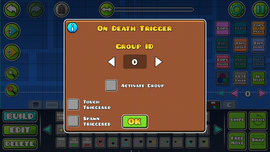 | The On Decease Trigger triggers an action upon the player's icon's death. The actor must outset entitle the trigger to a group of objects with an ID. Then, the histrion may choose to either activate or disable the group of objects. This trigger includes the Spawn-Triggered and Touch on-Triggered options and appears as pinkish in the level editor. |
Source: https://geometry-dash.fandom.com/wiki/Triggers
Posted by: vazquezbence1954.blogspot.com

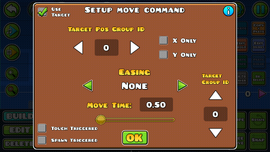
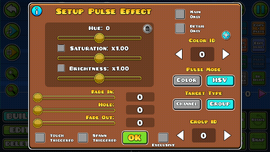
0 Response to "How To Animate Items In Geometry Dash"
Post a Comment